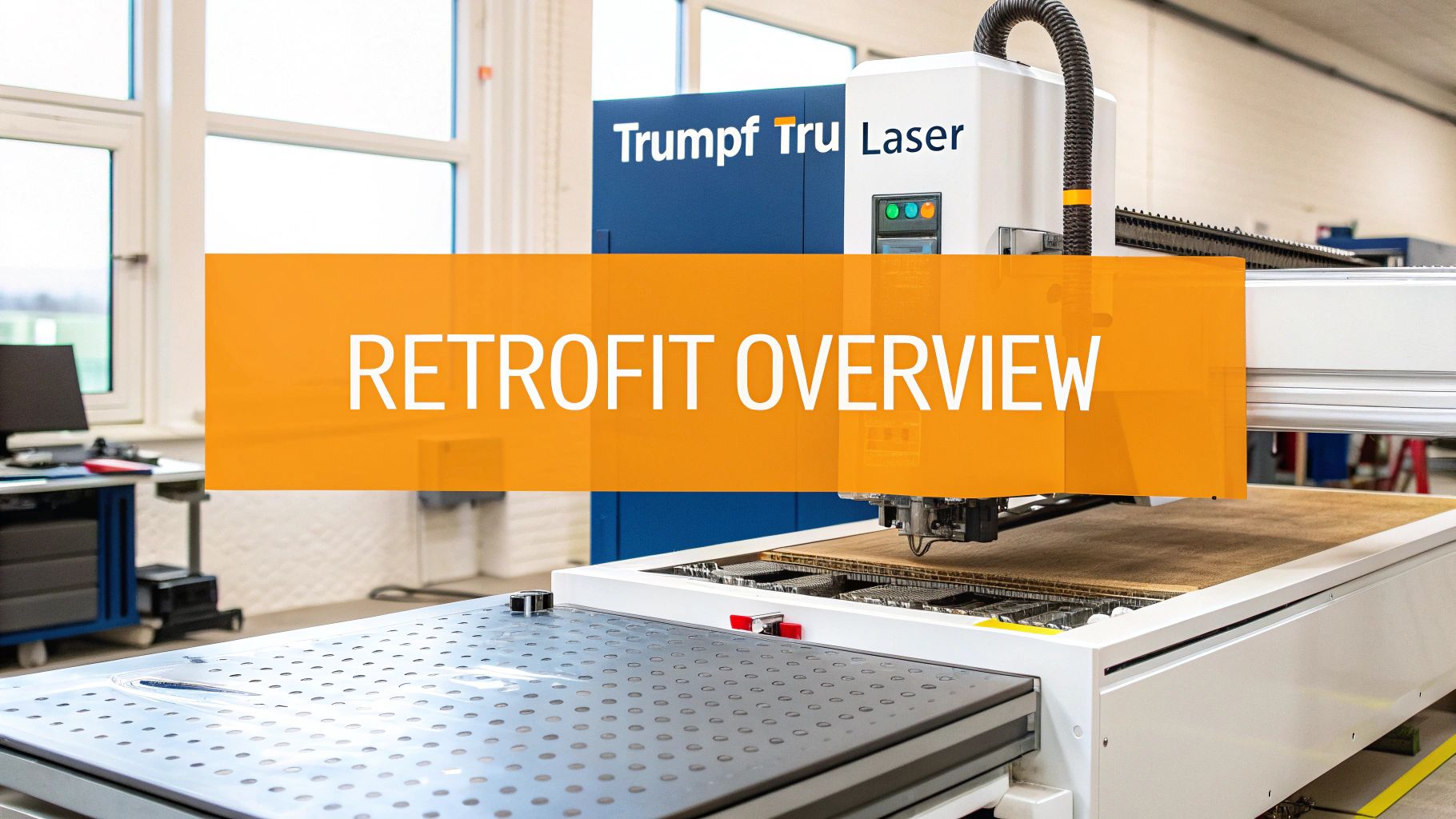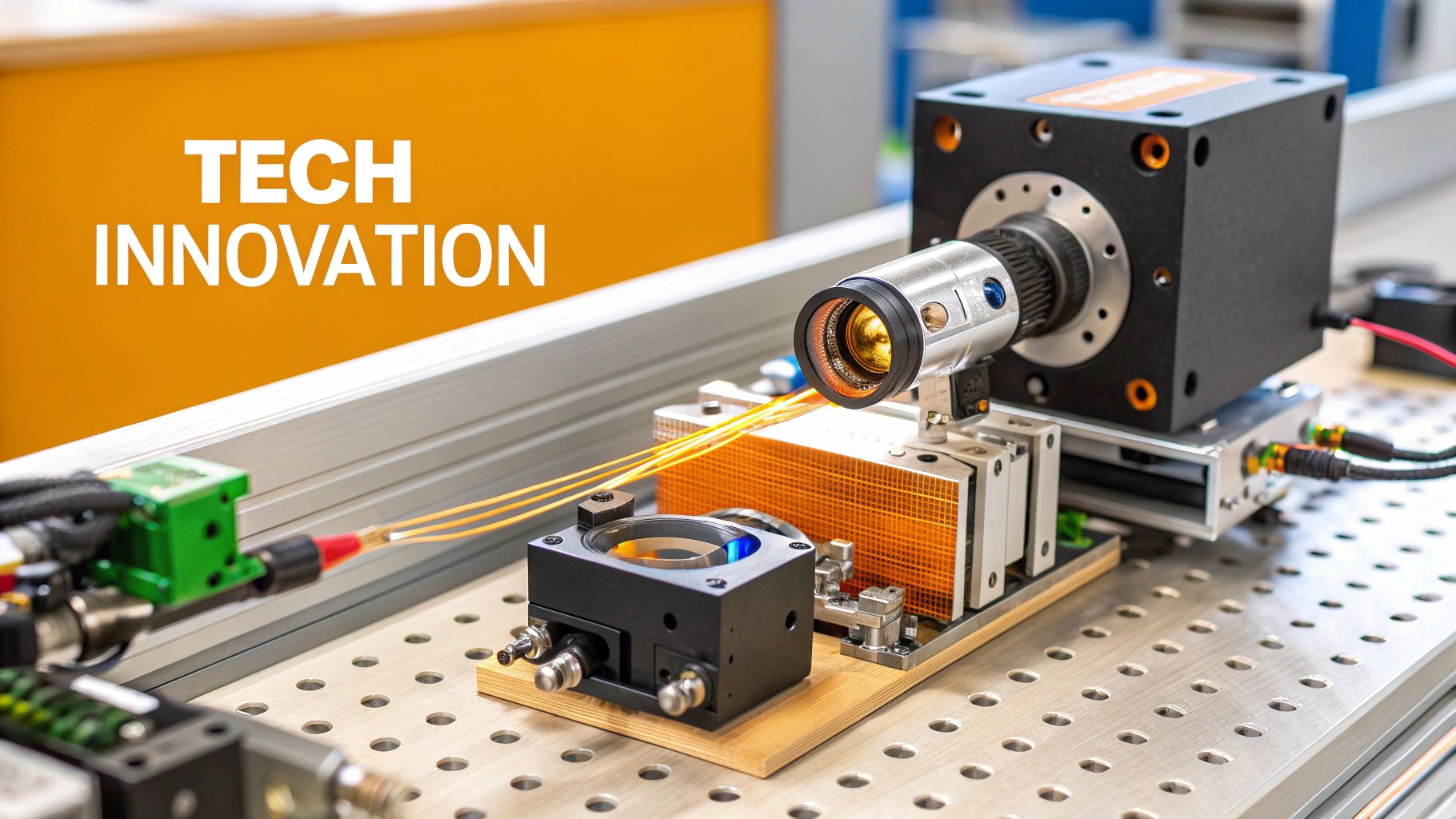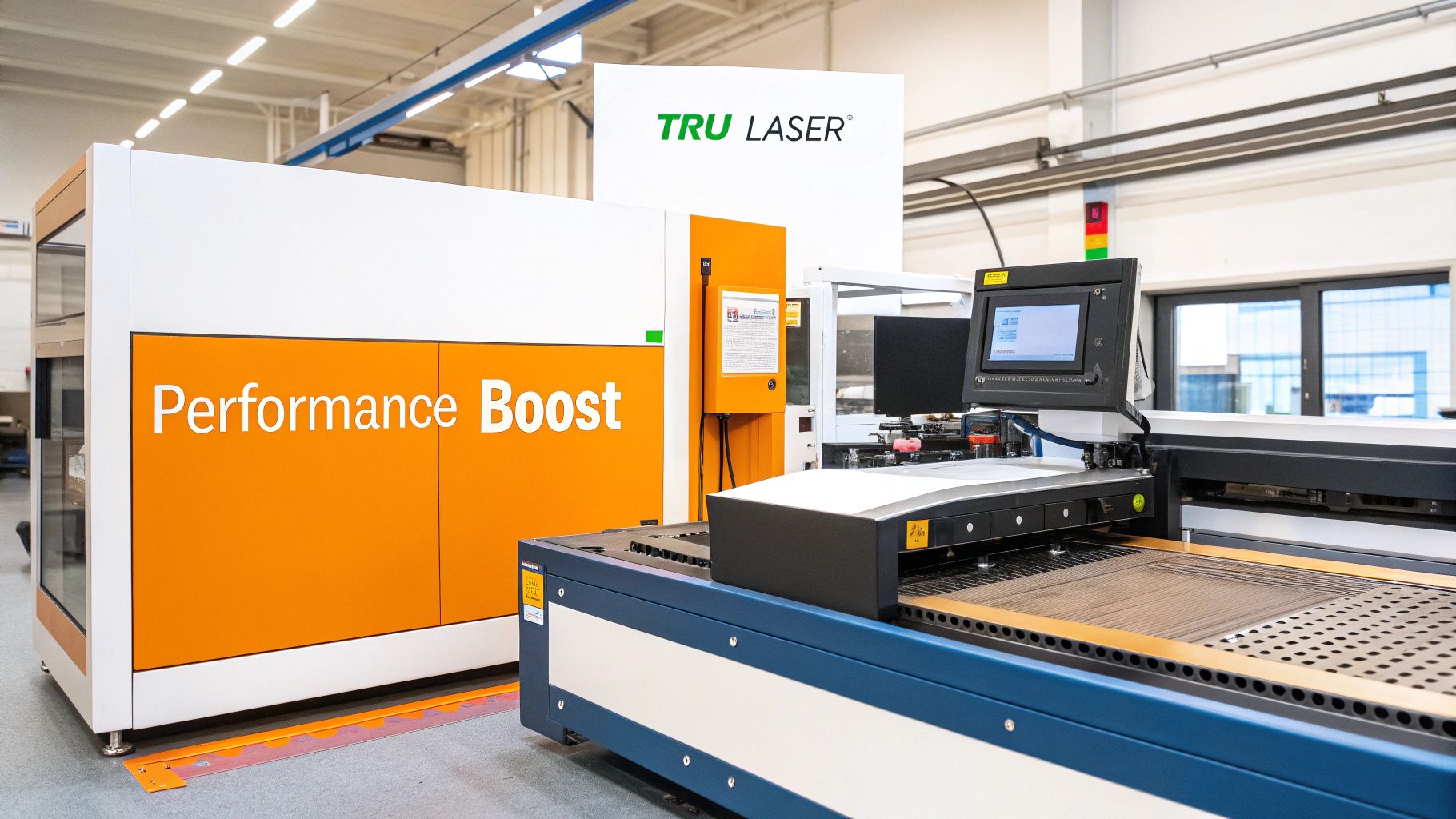Why Smart Manufacturers Choose Trumpf TRU LASER Retrofits
Is a Trumpf TRU LASER retrofit right for your facility? Many production managers wrestle with this decision, balancing potential benefits against the disruption of implementation. The answer, surprisingly often, is yes. Retrofitting presents a strong alternative to complete machine replacement, offering distinct advantages for manufacturers looking ahead.
Preserving Capital While Boosting Performance
A major reason for the increasing interest in Trumpf TRU LASER retrofits is the significant capital savings. Buying a new laser cutting system is a major investment. A retrofit, however, allows manufacturers to modernize their current machines at a much lower cost. This preserves capital for other important uses, like research and development or employee training. Retrofits often lead to immediate performance gains, increasing cutting speeds and overall precision.
Minimizing Downtime and Maintaining Operational Continuity
A Trumpf TRU LASER retrofit minimizes downtime compared to a full machine replacement, ensuring production continues smoothly. The retrofitting process is generally much quicker than a new installation, allowing manufacturers to get back to full capacity faster. This speed is essential in today's demanding production environment, where downtime translates directly to lost revenue. For further insights on laser technologies, check out: Laser Industry Insights.
Extending Equipment Lifespan and Embracing New Technologies
Retrofitting revitalizes older Trumpf laser systems. Upgrading key components significantly extends the working life of existing equipment. This not only postpones the need for expensive replacements, but also allows access to the latest laser advancements. TRUMPF, a leader in laser technology, offers solutions like BrightLine fiber and Nano Joint, improving precision and reducing post-processing needs. A key element of TRUMPF's retrofitting success is its ability to upgrade CO2 lasers to fiber laser technology, drastically increasing efficiency and lowering operational costs. One metal fabrication company saw thousands in savings on electricity and gas, alongside increased production speed, after upgrading to a fiber laser system. Learn more about this transformation here. This lets companies stay competitive without constantly buying new machines.
Choosing the Right Retrofit for Your Needs
Trumpf laser systems vary, and the right retrofit depends on the specific model and condition. Older CO2 laser systems are excellent candidates for fiber laser retrofits, gaining major improvements in efficiency and performance. Newer systems may benefit from more focused upgrades, like component or software enhancements. Consulting with a qualified Trumpf TRU LASER retrofit specialist is essential to determine the best approach for your particular situation.

CO2 to Fiber: The Game-Changing Retrofit Transformation

Switching from a CO2 laser to a fiber laser in your existing Trumpf TRU LASER system is more than just swapping parts. It dramatically changes your processing capabilities, impacting everything from cutting speed and the range of materials you can work with, to your operating costs and the overall life of your equipment. Let’s delve into this significant retrofit.
Understanding the Core Technology Differences
The core of the Trumpf TRU LASER retrofit is replacing the CO2 laser source with a fiber laser source. This change unlocks a wealth of performance boosts. CO2 lasers, though effective, use a complex system of mirrors and gases to create the laser beam.
Fiber lasers, on the other hand, generate the beam within a fiber optic cable. This results in a more focused, efficient, and powerful beam.
For instance, fiber lasers are excellent at cutting reflective materials like copper and brass, materials that can pose challenges for CO2 lasers. Fiber lasers also offer substantially higher energy efficiency, leading to lower electricity bills and a reduced environmental impact.
To illustrate these improvements, let's look at a direct comparison:
To make the performance differences clear, we've put together a comparison table:
CO2 vs. Fiber Laser Technology Comparison This table compares key performance metrics between traditional CO2 lasers and modern fiber laser systems following a retrofit upgrade.
| Performance Metric | CO2 Laser | Fiber Laser | Improvement Factor |
|---|---|---|---|
| Cutting Speed (Mild Steel, 1mm) | 20 m/min | 60 m/min | 3x |
| Energy Efficiency | 8-10% | 30-40% | 4x |
| Operating Costs | High (gas, mirrors) | Lower (electricity) | Significant Reduction |
| Maintenance | Frequent (mirror alignment, gas refills) | Less Frequent | Significant Reduction |
| Cutting Reflective Materials | Challenging | Excellent | Dramatic Improvement |
This table showcases the significant advantages that a fiber laser retrofit can offer. The enhanced speed, efficiency, and reduced operational costs make it a valuable upgrade for many businesses.
The Trumpf TRU LASER Retrofit Process: A Closer Look
A Trumpf TRU LASER retrofit starts with a thorough evaluation of your current system. Technicians assess the machine's mechanics, motion system, and control software. This assessment determines if a retrofit is feasible and identifies any necessary supporting upgrades.
The retrofit process involves replacing the CO2 laser source and the related beam delivery optics. It also includes integrating a new fiber laser cutting head. Typically, the existing motion system and machine frame remain unchanged. This modular approach minimizes downtime and keeps the operator interface familiar.
Following installation, the system goes through rigorous testing and calibration. Operators are trained on the specifics of fiber laser cutting, allowing them to take full advantage of the new technology. This detailed process ensures a smooth transition and maximizes your return on investment.
Addressing Common Retrofit Challenges
While Trumpf TRU LASER retrofits provide significant advantages, it's important to be aware of potential challenges. Downtime during installation is a common concern. However, skilled retrofit providers can schedule the installation strategically to minimize disruptions.
Another consideration is operator training. Even though the machine interface typically remains the same, operators need to learn the characteristics of fiber laser cutting.
Open communication with your retrofit provider is key to successfully navigating these challenges. Clear expectations, detailed planning, and a proactive approach to training can ensure a smooth transition and help you realize the full potential of your upgraded Trumpf TRU LASER system. The shift from CO2 to fiber laser technology substantially improves cutting performance and operational efficiency, making it a powerful investment for manufacturers seeking a competitive edge.
Connecting Your Shop Floor Through Strategic Retrofits
A Trumpf TRU LASER retrofit offers more than just a performance boost. It's a bridge to the digital future of manufacturing, transforming older machines into networked, data-driven workhorses. These retrofits seamlessly integrate into modern production environments, empowering manufacturers to optimize processes and make data-backed decisions without the significant cost of full system replacements.
Connectivity Features of Modern Trumpf TRU LASER Retrofits
Modern Trumpf TRU LASER retrofit packages include key connectivity features designed to link legacy equipment with current digital manufacturing best practices. Many retrofits include interfaces compatible with OPC UA, a platform-independent standard for industrial automation communication. This allows seamless data flow between the retrofitted machine and other shop floor equipment, regardless of brand or age.
Modern retrofits also often feature sensors and data acquisition systems for real-time machine performance monitoring. This data feeds into central monitoring systems, enabling remote monitoring and predictive maintenance. This proactive approach reduces downtime and optimizes machine performance.
Integrating Retrofits into Existing Production Environments
Integrating a Trumpf TRU LASER retrofit into an existing production environment is generally straightforward. The process focuses on upgrading key parts, such as the laser source and cutting head, while keeping the existing machine frame and motion system. This modular method minimizes disruption and allows for quick operator adaptation. However, network compatibility and data security are crucial factors to consider during integration.
TRUMPF significantly impacts industries like automotive and aerospace globally. By offering upgrades like OPC UA retrofit boxes for older systems, TRUMPF helps manufacturers transition to Industry 4.0 compliance. This is particularly important in key markets like the U.S., Germany, and China, where TRUMPF has seen substantial growth. Learn more about TRUMPF's solutions here.
Practical Examples of Shop Floor Integration
The advantages of a connected shop floor are clear. A retrofitted Trumpf TRU LASER automatically reports production data, including cutting times, material usage, and error rates. This data offers insights into production efficiency and identifies bottlenecks. This information can be used to optimize production schedules, minimize waste, and improve overall throughput.

Remote monitoring features enable managers to track machine performance from any location, facilitating faster responses to potential problems. For instance, if a machine shows signs of wear, maintenance can be scheduled proactively, avoiding expensive downtime and extending the machine's life. These connected systems create a more efficient, data-driven, and ultimately, more profitable manufacturing operation. This allows manufacturers to be more agile in response to changing market conditions and customer needs.
The Real Numbers: Trumpf TRU LASER Retrofit ROI Analysis
Investing in a Trumpf TRU LASER retrofit demands careful financial planning. This section offers a practical look at the return on investment (ROI), moving beyond marketing buzzwords to provide a clear understanding of the financial implications. We'll explore how manufacturers evaluate the fiscal impact of these retrofits, equipping you with the tools to perform your own analysis.
Understanding the Complete Cost Picture
A Trumpf TRU LASER retrofit involves several cost factors beyond the initial price tag. Accurately assessing the complete financial picture is the first step in a robust ROI analysis.
- Retrofit Kit: This includes the essential hardware such as the fiber laser source, cutting head, and optical components.
- Installation Expenses: Consider the costs associated with professional installation. This includes labor, travel expenses for technicians, and any necessary machine modifications.
- Training: While extensive retraining isn't usually required, operators will need to familiarize themselves with the new fiber laser technology. Budget for any necessary training materials or sessions.
- Production Interruption: Downtime during the retrofit process can impact production. Minimizing this interruption is key. Experienced retrofit providers often schedule work during off-peak hours or weekends to lessen disruption.
Implementing appropriate software is key in a modern shop floor retrofit. You may find this resource helpful: small business automation software.
Quantifying Tangible Benefits
The financial advantages of a Trumpf TRU LASER retrofit extend well beyond the sticker price. Significant long-term benefits contribute to a strong ROI.
- Reduced Energy Consumption: Fiber lasers are remarkably more energy-efficient than their CO2 predecessors. Typical savings range from 30-40%, directly lowering your utility bills. This also reduces your company's environmental impact.
- Lower Maintenance Costs: Fiber lasers require less maintenance due to their simpler design and fewer consumable parts. This translates to reduced operational expenses and less downtime.
- Improved Material Utilization: The precision of fiber lasers often results in less material scrap. This can create significant savings, particularly when processing costly materials.
- Throughput Gains: Fiber lasers cut faster than CO2 lasers, increasing throughput and overall productivity. This boost in efficiency allows you to process more jobs in less time, positively affecting your bottom line.
Calculating Payback Periods and ROI
Calculating payback periods and ROI can vary across different industries. Understanding these calculations helps determine the long-term financial viability of the retrofit.
- Payback Period: This calculation determines the time required to recoup the initial investment through cost savings and increased revenue. A shorter payback period is generally preferred.
- Return on Investment (ROI): This metric indicates the profitability of the retrofit as a percentage of the initial investment. A higher ROI indicates a more profitable undertaking.
Several key factors significantly influence ROI:
- Existing Machine Condition: A well-maintained machine is a stronger candidate for a retrofit, maximizing its extended lifespan and the return on your investment.
- Production Volume: Facilities with higher production volumes typically experience faster ROI due to the magnified impact of efficiency improvements.
- Material Costs: When working with high-value materials, the savings from reduced waste become even more substantial.
Hidden Financial Benefits
Beyond the readily quantifiable benefits, several less obvious advantages can contribute to the overall financial success of a TRU LASER retrofit. These hidden benefits can significantly enhance the long-term value proposition.
- Reduced Scrap Rates: The enhanced precision of fiber lasers minimizes cutting errors, resulting in fewer rejected parts and lower material waste.
- Expanded Material Capabilities: Fiber lasers can process a broader range of materials, potentially creating new revenue opportunities by expanding your service offerings.
- Improved Product Quality: The superior quality of cuts produced by fiber lasers can improve the overall quality of your final products, potentially increasing customer satisfaction and market competitiveness.
You might be interested in: How to master...

To illustrate the potential cost savings and return on investment, let's examine a typical cost-benefit analysis for a Trumpf TRU LASER retrofit.
The following table outlines typical cost factors and benefits to consider when evaluating a TRU LASER retrofit project.
| Factor | Before Retrofit | After Retrofit | Annual Impact |
|---|---|---|---|
| Energy Consumption | $10,000 | $6,000 | $4,000 Savings |
| Maintenance Costs | $5,000 | $2,000 | $3,000 Savings |
| Material Waste | $3,000 | $1,000 | $2,000 Savings |
| Throughput (Additional Revenue) | $50,000 | $60,000 | $10,000 Gain |
As this table demonstrates, a Trumpf TRU LASER retrofit can generate significant annual savings and revenue increases. These figures will vary depending on your specific application and production volume. Consult with an experienced retrofit provider for a tailored assessment.
By carefully evaluating these factors and conducting a thorough ROI analysis, manufacturers can confidently assess the financial benefits of a Trumpf TRU LASER retrofit. This data-driven approach empowers businesses to make strategic investments that improve their operational capabilities and enhance their competitive edge. Remember to engage with experienced retrofit providers for personalized consultations and to explore available financing options.
Trumpf TRU LASER Retrofit Success Stories
Real-world examples showcase the impact of a Trumpf TRU LASER retrofit. These success stories highlight the tangible advantages manufacturers gain after upgrading their systems. These aren't just potential improvements; they're quantifiable results achieved by companies modernizing their laser cutting operations.
Precision Parts Manufacturer: Enhanced Throughput and Energy Efficiency
A precision parts manufacturer specializing in intricate, small components faced growing pressure to improve lead times without sacrificing quality. Their existing CO2 laser cutter struggled to meet demand. By retrofitting their Trumpf laser with a fiber laser source, they achieved a 40% increase in throughput and simultaneously reduced energy consumption by 60%.
This twofold benefit improved production capacity and significantly lowered operating costs. The increased cutting speeds of the fiber laser allowed for faster order fulfillment, while the lower energy consumption contributed to more sustainable and cost-effective operations.
Aerospace Component Supplier: Wider Range of Materials
An aerospace component supplier needed to process a broader spectrum of materials, including reflective metals like copper and brass, to fulfill new contracts. Their existing CO2 laser wasn't capable of this. A Trumpf TRU LASER retrofit offered the perfect solution.
The upgraded system allowed them to handle these new materials seamlessly, integrating into existing workflows without disruption. This broadened their capabilities, opening new business opportunities and making them more competitive within the aerospace market. The retrofit proved more economical than purchasing a brand new laser cutting system.
Custom Fabricator: Faster Turnarounds
A custom fabricator working with tight deadlines and fluctuating order volumes needed to improve cutting speeds to satisfy customer demands. Their aging CO2 laser cutter created production bottlenecks. A Trumpf TRU LASER retrofit significantly improved their cutting speed and precision.
This led to shorter lead times and better on-time delivery rates, boosting customer satisfaction and strengthening their reputation for reliability. The faster processing also freed up capacity, allowing them to take on more work and increase revenue. Read also: How to master...
Overcoming Challenges, Discovering Additional Advantages
While the results are impressive, these cases also emphasize the importance of meticulous planning and implementation. Each company encountered distinct challenges during the retrofit. Some found unexpected software compatibility issues, while others navigated a brief learning curve as operators adapted to the new fiber laser technology.
These obstacles were overcome by partnering with experienced retrofit providers. Furthermore, several manufacturers uncovered unexpected benefits after the retrofit, including improved cut quality, less material waste, and reduced maintenance. These unforeseen advantages further increased their return on investment.
These successes highlight the value of a well-planned Trumpf TRU LASER retrofit. By examining these real-world experiences, manufacturers considering a similar upgrade can approach the process with more confidence and achieve comparable outcomes. These examples demonstrate that modernizing current equipment is a practical and often preferable option to buying entirely new machinery.
Your Trumpf TRU LASER Retrofit Roadmap
Deciding to retrofit your Trumpf TRU LASER is a significant investment in the future of your production. This roadmap offers a strategic guide, leading you from the initial assessment to post-installation validation, ensuring a successful and cost-effective retrofit.
Pre-Retrofit Assessment: Laying the Foundation
Before you even contact potential providers, a thorough internal assessment is crucial. Start by evaluating your current Trumpf TRU LASER equipment. What are its limitations? Where does it fall short of meeting your present production demands and anticipated future needs? Recognizing these gaps is a key indicator that a retrofit might be the right solution.
Bringing all stakeholders on board – operators, maintenance personnel, and financial decision-makers – is essential. A shared understanding of the project's goals and potential benefits will ensure a smooth and collaborative transition. This initial alignment lays the foundation for a focused and effective retrofit project.
Choosing the Right Retrofit Partner: Asking the Right Questions
Selecting the right retrofit partner is paramount to the success of your project. Don't simply focus on the initial price quote. Instead, delve deeper during consultations. Does the potential provider have a proven track record with Trumpf TRU LASER systems? Can they furnish references from similar manufacturers? A deep understanding of Trumpf technology is essential.
Inquire about their proposed solution: How will they minimize production disruptions during the retrofit process? What kind of training and ongoing support will they offer post-installation? Thorough questioning will reveal a provider's true expertise and commitment to customer success.
Comparing Proposals: Looking Beyond the Price Tag
When comparing proposals, look beyond the initial cost. Evaluate the entire scope of work. Which components will be replaced or upgraded? What warranties are included? The lowest price doesn't always represent the best value.
Factor in the provider's experience, reputation, and the proposed implementation timeline. Consider the long-term value proposition: Does the proposal include ongoing support and maintenance options? A comprehensive evaluation of both short-term costs and long-term benefits will help you identify the optimal solution.
Minimizing Production Disruption: Strategic Implementation
Minimizing production downtime is key during the retrofit implementation. Collaborate closely with your chosen provider to create a strategic installation plan. Can the work be completed during off-peak hours or weekends? Can some production be temporarily shifted to other machines? Detailed planning and coordination are essential for maintaining operational continuity.
Operator Training and Workflow Adaptation: Ensuring a Smooth Transition
Providing operator training on the new technology is crucial for a seamless transition. Even if the machine interface remains familiar, the characteristics of the upgraded technology might be different. Adequate training will maximize operator efficiency.
Discuss workflow adaptations with your retrofit provider. How will the new technology impact current processes? Are there opportunities to optimize workflows? Proactive planning for training and workflow adjustments will minimize the learning curve and empower operators to quickly leverage the upgraded system's full capabilities.
Post-Installation Validation: Ensuring Optimal Performance
Once the installation is complete, validate the retrofitted system’s performance against your expectations. Develop a comprehensive validation plan with your provider. Which key performance indicators (KPIs) will be measured? What acceptance criteria will be used? Thorough validation ensures you're realizing the full return on your investment.
Troubleshooting and Adjustments: Addressing Common Challenges
Even with careful planning, adjustments might be necessary after the retrofit. Discuss potential troubleshooting strategies with your provider. What are the common issues that can arise with newly retrofitted systems? How will these be addressed? Proactive planning for potential challenges will minimize their impact and ensure swift resolutions.
A Trumpf TRU LASER retrofit can dramatically improve your laser cutting operations. Following this roadmap allows you to navigate the process effectively, minimize disruptions, and maximize your investment. Transform your existing equipment into a modern, high-performing asset, and advance your manufacturing capabilities.
Ready to learn more? Visit Laser Insights China for in-depth information on laser technologies and expert guidance for manufacturers.

